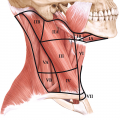Surgical resection was the principal therapy for breast cancer for centuries. However, over the past 30 years, as therapeutic interventions have been modified and outcomes have been studied, aggressiveness of the procedures has substantially been reduced. Currently, large chest wall resections and reconstructions are offered only to select patients with locoregional disease. This chapter evaluates the indications and contraindications for this operation, discusses procedural technique, and reviews the complications.
William S. Halsted is often credited with evolution and advancement of the radical mastectomy. He thought that breast cancer advanced locally and then spread to regional lymph nodes prior to reaching distal sites.1 Therefore, extirpation of the breast cancer required a complete en bloc excision of the skin, both pectoral muscles, and all levels of lymph nodes of the axilla (I, II, III) and lower neck, and sacrifice of the thoracodorsal artery, vein, and nerve together with the long thoracic nerve.2–5
Today, with the advent of early detection and neoadjuvant therapies, surgeons perform major procedures, such as the Halsted mastectomy and large chest wall resections, sparingly (<2%). Cytoreduction through radiotherapy and chemotherapy permits the treatment of breast cancer patients with less aggressive surgical procedures. However, the oncologic surgeon will face certain presentations of advanced disease and locoregional recurrence in which a chest wall resection would be appropriate, such as an isolated chest wall or solitary lymph node recurrence;6–9 curative treatment for removing a locally advanced primary cancer; and palliation, with the goal of treating pain, drainage, ulceration, or continued growth.6,7,10,11
A number of contraindications exist for extensive chest wall resection. Definitive contraindications include systemic disease and multifocal recurrence. Other features that are suggestive of a poor prognosis with a large resection are short disease-free interval, poor pulmonary function, and additional high operative risk factors6,7 (Table 157-1). Specifically, studies confirm that age less than 35 years, disease-free interval less than 2 years, and positive lymph nodes at first diagnosis are poor prognostic factors.8,9,12–16
Currently, with the major advances made in breast cancer treatment and perioperative management, more appropriate patients can be selected to undergo major chest wall resections instead of less discriminatory measures, as was done in Halsted’s day. In addition, recent surgical developments, including procedures related to flap reconstruction with improvements in anesthesia, antibiotics, tissue augmentation technology, and intensive care, have allowed more acceptable morbidity and mortality rates related to chest wall resections.10,17
Acceptable outcomes for this procedure require extensive preoperative evaluation and planning by the surgical team, which often includes a surgical oncologist or thoracic surgeon who performs the resection and a plastic surgeon who completes the reconstruction. This assessment involves confirmatory radiological and pathological indications for the resection, evaluating patient characteristics, with adequate imaging, and arranging a strategy for reconstruction. During the preoperative evaluation, any pulmonary, cardiac, or nutrition problems must be recognized, and smoking cessation for at least 6 to 8 weeks is strictly enforced.10 In addition, adequate imaging must be acquired to assist with staging and preoperative planning. Specifically, patients need to be evaluated for metastatic disease and pleural effusions, chest wall anatomy must be defined, and tumor location must be established, including evaluation for pleural/lung invasion. Multiple imaging modalities are available; however, MRI, CT, and PET are the techniques most often used for the evaluation of advanced chest and breast cancer recurrence. Finally, reconstructive and flap planning should be considered. These issues can be influenced by cancer location and stage, previous operative and radiation history, pulmonary functions, and body habitus.6,7,11
This is a multistep procedure that requires careful execution. To start, a double lumen endotracheal tube should be placed during intubation and then the patient must be positioned appropriately. Depending on the location of the breast cancer and the optimal flap for reconstruction, the patient may be placed in the supine or lateral decubitus position. In some cases, the patient may need to be repositioned during the operation. Because this is a cancer operation, adequate margins must be obtained. Therefore, at least 2 cm, and according to some studies up to 5 cm,6–8,12 surrounding the planned area of resection should be included and the resection should be carried at least one intercostal space above and below the tumor. Prior to initiating resection, full-thickness punch biopsies should be generously taken from the planned margins and sent for frozen sections to verify that an adequate area has been included, ensuring negative pathological margins. Lastly, before proceeding, the ipsilateral lung should be deflated utilizing the double lumen tube to prevent parenchymal injuries. The thoracotomy incision is begun at the superior margin of resection and carried into the pleural space (Fig. 157-1). Adhesions from previous surgeries or radiation can be bluntly dissected to free the lung from the chest wall. Iatrogenic pneumonotomies should be repaired with nonabsorbable suture. The incision can then be extended around the margin edges and through the intercostal muscles. The intercostal neurovascular bundles should be identified just inferior to each rib and ligated. The periosteum of the ribs is elevated; thereafter, the ribs should be divided along the planned margins for resection (Fig. 157-2). If the area of resection includes the sternum, a partial or (rarely) total sternotomy may be required. In this case, the ipsilateral internal mammary artery will need to be identified and ligated. Once the specimen is free, it can be removed en bloc with the deep margin, comprised of the parietal pleura.6,7,12 Finally, the underlying lung will need to be examined for unrecognized injury or invasion. Should areas of concern exist, partial pneumonectomy may be completed with a stapled wedge resection. Before proceeding with reconstruction, two chest tubes should be placed through separate lateral incisions. An angled tube should be positioned along the diaphragm, while a straight tube is directed into the apex of the pleural space.6,7
Stay updated, free articles. Join our Telegram channel

Full access? Get Clinical Tree






